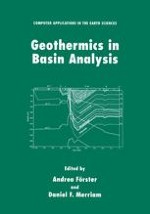1999 | OriginalPaper | Chapter
Thermal History of a Deep Well in the Michigan Basin: Implications for a Complex Burial History
Authors : William D. Everham, Jacqueline E. Huntoon
Published in: Geothermics in Basin Analysis
Publisher: Springer US
Included in: Professional Book Archive
Activate our intelligent search to find suitable subject content or patents.
Select sections of text to find matching patents with Artificial Intelligence. powered by
Select sections of text to find additional relevant content using AI-assisted search. powered by
Most of the Paleozoic strata in the Michigan Basin exhibit levels of thermal maturity that are higher than expected given present-day geothermal gradients, burial depths, and heat flow. Because of the complexity of the basin’s thermal history, no previous study has resulted in a single model that predicts the observed thermal maturity for the entire stratigraphic section in the basin. Two hypotheses, however, have resulted from previous studies. They are: (1) that elevated basal heat flow affected the basin during its early history, and (2) that a significant amount of Late Carboniferous and Permian strata must at one time have been present in the basin.This paper describes the results of several 1-dimensional model simulations of the time-dependent conductive thermal history of the Mobil-Jelinek well, located in Shiawassee County, Michigan. The Mobil-Jelinek well has been the focus of several previous studies because of abundance of thermal maturity data for the well. These data were used in this study to constrain some model input parameters and to evaluate the modeling results. A substantial subsurface database also was used to construct isopachous maps and structural cross sections that aided reconstruction of a burial history for the Mobil-Jelinek well.Results of the best-fit model predict thermal maturities that are consistent with observed data for the entire stratigraphic section of the well. The best-fit model requires elevated heat flow (greater than present-day values) through the basin until the end of the Silurian. A significant amount of erosion (2.3 km) also is incorporated in the model at the Silurian/Devonian boundary. This boundary represents the transition from the Tippecanoe to Kaskaskia Sequences. Finally, about 2 km of excess Late Carboniferous and Permian strata (which was eroded during the Triassic) is included in the best-fit model.
